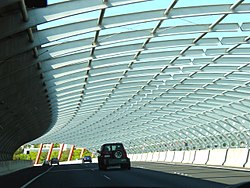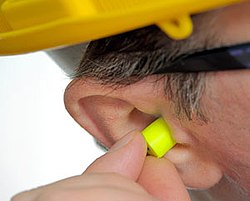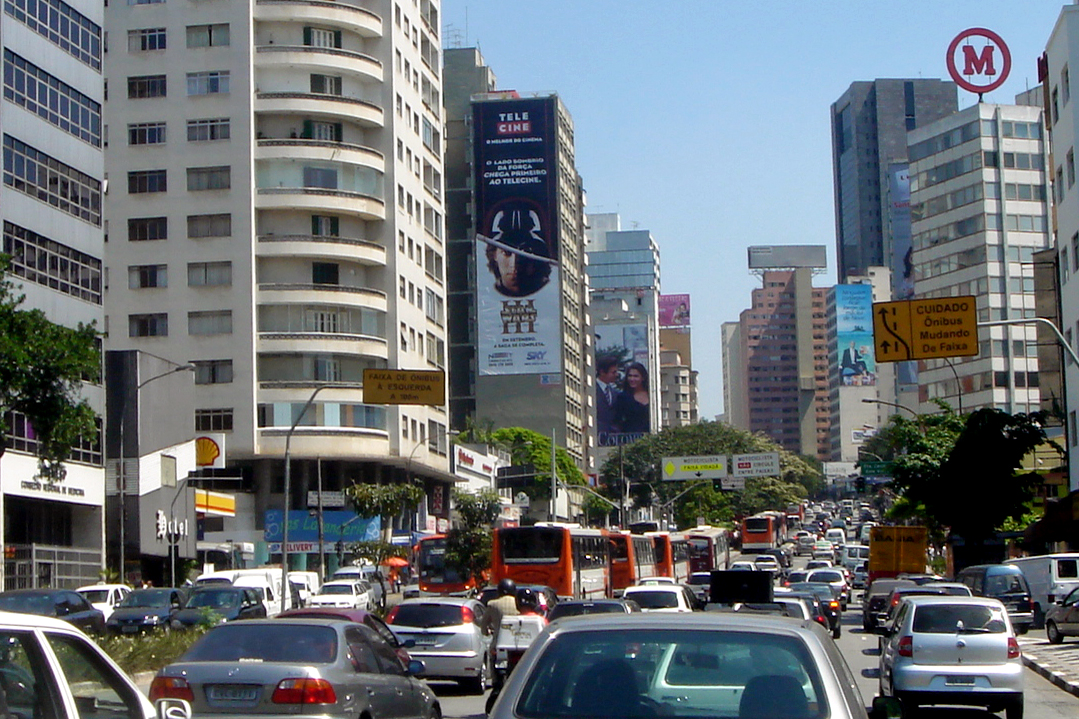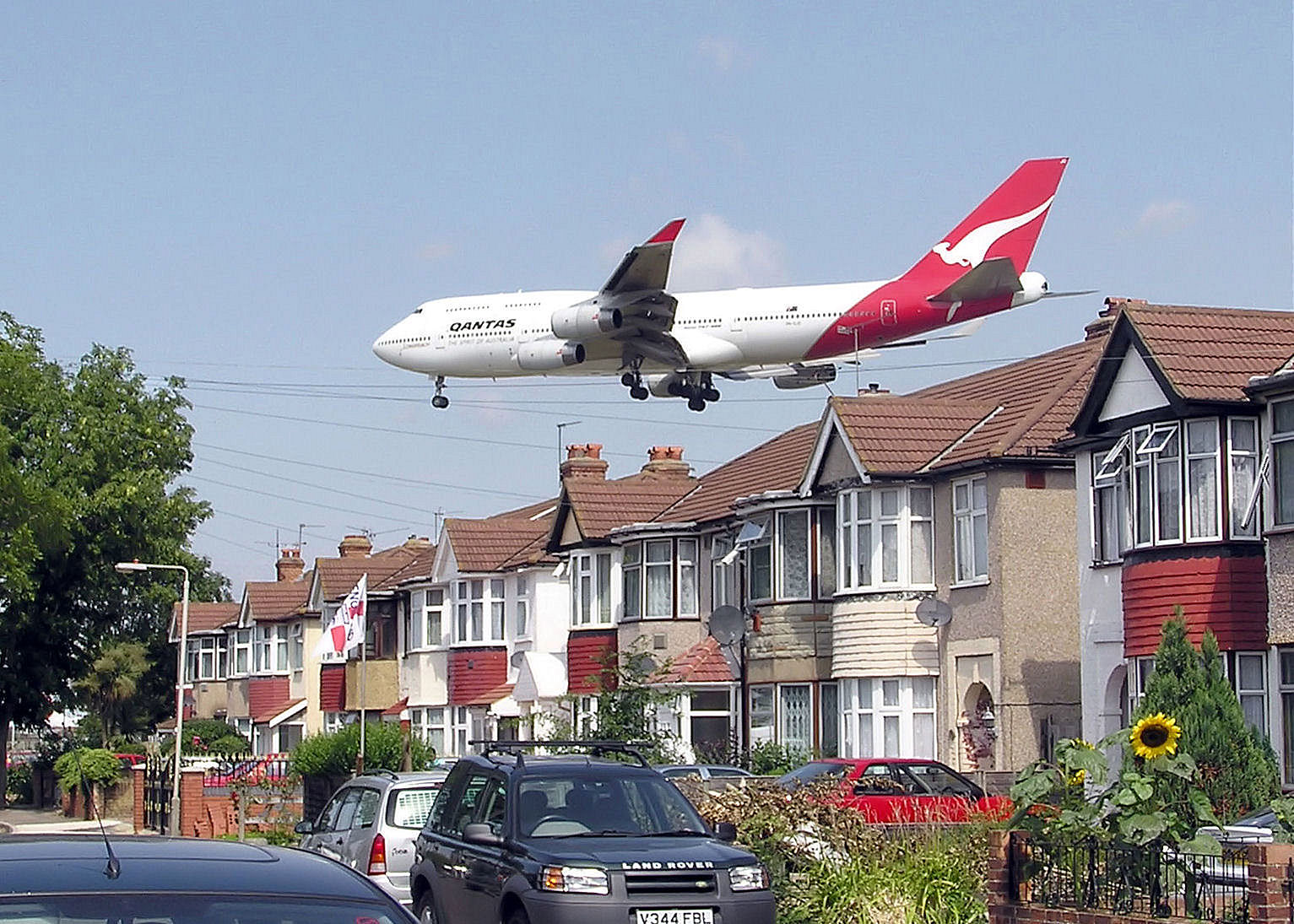Noise pollution
Noise pollution, also known as environmental noise or sound pollution, is the propagation of noise with harmful impact on the activity of human or animal life. The source of outdoor noise worldwide is mainly caused by machines, transport, and propagation systems.[1][2] Poor urban planning may give rise to noise disintegration or pollution, side-by-side industrial and residential buildings can result in noise pollution in the residential areas. Some of the main sources of noise in residential areas include loud music, transportation (traffic, rail, airplanes, etc.), lawn care maintenance, construction, electrical generators, explosions, and people. Documented problems associated with urban environment noise go back as far as ancient Rome.[3] Noise is measured in Decibel (dB). Noise pollution associated with household electricity generators is an emerging environmental degradation in many developing nations. The average noise level of 97.60 dB obtained exceeded the WHO value of 50 dB allowed for residential areas.[4] Research suggests that noise pollution is the highest in low-income and racial minority neighborhoods.[5]
High noise levels can contribute to cardiovascular effects in humans and an increased incidence of coronary artery disease.[6][7] In animals, noise can increase the risk of death by altering predator or prey detection and avoidance, interfere with reproduction and navigation, and contribute to permanent hearing loss.[8] While the elderly may have cardiac problems due to noise, according to the World Health Organization, children are especially vulnerable to noise, and the effects that noise has on children may be permanent.[9] Noise poses a serious threat to a child's physical and psychological health, and may negatively interfere with a child's learning and behavior.[10]
Health
Humans

Noise pollution affects both health and behavior. Unwanted sound (noise) can damage physiological health. Noise pollution is associated with several health conditions, including cardiovascular disorders, hypertension, high stress levels, tinnitus, hearing loss, sleep disturbances, and other harmful and disturbing effects.[6][11][12][13][14] According to a 2019 review of the existing literature, noise pollution was associated with faster cognitive decline.[15]
Across Europe, according to the European Environment Agency, an estimated 113 million people are affected by road traffic noise levels above 55 decibels, the threshold at which noise becomes harmful to human health by the WHO's definition.[16]

Sound becomes unwanted when it either interferes with normal activities such as sleep or conversation, or disrupts or diminishes one's quality of life.[17] Noise-induced hearing loss can be caused by prolonged exposure to noise levels above 85 A-weighted decibels.[18] A comparison of Maaban tribesmen, who were insignificantly exposed to transportation or industrial noise, to a typical U.S. population showed that chronic exposure to moderately high levels of environmental noise contributes to hearing loss.[11]
Noise exposure in the workplace can also contribute to noise-induced hearing loss and other health issues. Occupational hearing loss is one of the most common work-related illnesses in the U.S. and worldwide.[19]
It is less clear how humans adapt to noise subjectively. Tolerance for noise is frequently independent of decibel levels. Murray Schafer's soundscape research was groundbreaking in this regard. In his work, he makes compelling arguments about how humans relate to noise on a subjective level, and how such subjectivity is conditioned by culture.[20] Schafer also notes that sound is an expression of power, and as such, material culture (e.g., fast cars or Harley Davidson motorcycles with aftermarket pipes) tend to have louder engines not only for safety reasons, but for expressions of power by dominating the soundscape with a particular sound. Other key research in this area can be seen in Fong's comparative analysis of soundscape differences between Bangkok, Thailand and Los Angeles, California, US. Based on Schafer's research, Fong's study showed how soundscapes differ based on the level of urban development in the area. He found that cities in the periphery have different soundscapes than inner city areas. Fong's findings tie not only soundscape appreciation to subjective views of sound, but also demonstrates how different sounds of the soundscape are indicative of class differences in urban environments.[21]
Noise pollution can have negative affects on adults and children on the autistic spectrum.[22] Those with Autism Spectrum Disorder (ASD) can have hyperacusis, which is an abnormal sensitivity to sound.[23] People with ASD who experience hyperacusis may have unpleasant emotions, such as fear and anxiety, and uncomfortable physical sensations in noisy environments with loud sounds.[24] This can cause individuals with ASD to avoid environments with noise pollution, which in turn can result in isolation and negatively affect their quality of life. Sudden explosive noises typical of high-performance car exhausts and car alarms are types of noise pollution that can affect people with ASD.[22]
Wildlife
Noise can have a detrimental effect on animals, increasing the risk of death by changing the delicate balance in predator or prey detection and avoidance, and interfering the use of the sounds in communication, especially in relation to reproduction and in navigation. These effects then may alter more interactions within a community through indirect (“domino”) effects.[25] Acoustic overexposure can lead to temporary or permanent loss of hearing.
European robins living in urban environments are more likely to sing at night in places with high levels of noise pollution during the day, suggesting that they sing at night because it is quieter, and their message can propagate through the environment more clearly.[26] The same study showed that daytime noise was a stronger predictor of nocturnal singing than night-time light pollution, to which the phenomenon often is attributed. Anthropogenic noise reduced the species richness of birds found in Neoptropical urban parks.[27]
Zebra finches become less faithful to their partners when exposed to traffic noise. This could alter a population's evolutionary trajectory by selecting traits, sapping resources normally devoted to other activities and thus leading to profound genetic and evolutionary consequences.[28]
Underwater noise pollution due to human activities is also prevalent in the sea. Cargo ships generate high levels of noise due to propellers and diesel engines.[29][30] This noise pollution significantly raises the low-frequency ambient noise levels above those caused by wind.[31] Animals such as whales that depend on sound for communication can be affected by this noise in various ways. Even marine invertebrates, such as crabs (Carcinus maenas), have been shown to be negatively affected by ship noise.[32][33] Larger crabs were noted to be negatively affected more by the sounds than smaller crabs. Repeated exposure to the sounds did lead to acclimatization.[33]
Higher ambient noise levels also cause animals to vocalize more loudly, which is called the Lombard effect. Researchers have found that humpback whales' song lengths were longer when low-frequency sonar was active nearby.[34]
Noise pollution may have caused the death of certain species of whales that beached themselves after being exposed to the loud sound of military sonar.[35] (see also Marine mammals and sonar)
Noise control


The Hierarchy of Controls concept is often used to reduce noise in the environment or the workplace. Engineering noise controls can be used to reduce noise propagation and protect individuals from overexposure. When noise controls are not feasible or adequate, individuals can also take steps to protect themselves from the harmful effects of noise pollution. If people must be around loud sounds, they can protect their ears with hearing protection (e.g., ear plugs or ear muffs).[36] In recent years, Buy Quiet programs and initiatives have arisen in an effort to combat occupational noise exposures. These programs promote the purchase of quieter tools and equipment and encourage manufacturers to design quieter equipment.[37]
Noise from roadways and other urban factors can be mitigated by urban planning and better design of roads. Roadway noise can be reduced by the use of noise barriers, limitation of vehicle speeds, alteration of roadway surface texture, limitation of heavy vehicles, use of traffic controls that smooth vehicle flow to reduce braking and acceleration, and tire design. An important factor in applying these strategies is a computer model for roadway noise, that is capable of addressing local topography, meteorology, traffic operations, and hypothetical mitigation. Costs of building-in mitigation can be modest, provided these solutions are sought in the planning stage of a roadway project.
Aircraft noise can be reduced by using quieter jet engines. Altering flight paths and time of day runway has benefited residents near airports.
Legal status
Up until the 1970s governments tended to view noise as a "nuisance" rather than an environmental problem.
Many conflicts over noise pollution are handled by negotiation between the emitter and the receiver. Escalation procedures vary by country, and may include action in conjunction with local authorities, in particular the police.
India
Noise pollution is a major problem in India.[38] The government of India has rules and regulations against firecrackers and loudspeakers, but enforcement is extremely lax.[39] Awaaz Foundation is a non-governmental organization in India working to control noise pollution from various sources through advocacy, public interest litigation, awareness, and educational campaigns since 2003.[40] Despite increased enforcement and stringency of laws now being practised in urban areas, rural areas are still affected. The Supreme Court of India had banned playing of music on loudspeakers after 10pm. In 2015, The National Green Tribunal directed authorities in Delhi to ensure strict adherence to guidelines on noise pollution, saying noise is more than just a nuisance as it can produce serious psychological stress. However, implementation of the law continues to remain poor.[41]
Sweden
How noise emissions should be reduced, without the industry being hit too hard, is a major problem in environmental care in Sweden today. The Swedish Work Environment Authority has set an input value of 80 dB for maximum sound exposure for eight hours. In workplaces where there is a need to be able to converse comfortably the background noise level should not exceed 40 dB.[42] The government of Sweden has taken soundproofing and acoustic absorbing actions, such as noise barriers and active noise control.
United Kingdom
Figures compiled by rockwool, the mineral wool insulation manufacturer, based on responses from local authorities to a Freedom of Information Act (FOI) request reveal in the period April 2008 – 2009 UK councils received 315,838 complaints about noise pollution from private residences. This resulted in environmental health officers across the UK serving 8,069 noise abatement notices or citations under the terms of the Anti-Social Behaviour (Scotland) Act. In the last 12 months, 524 confiscations of equipment have been authorized involving the removal of powerful speakers, stereos and televisions. Westminster City Council has received more complaints per head of population than any other district in the UK with 9,814 grievances about noise, which equates to 42.32 complaints per thousand residents. Eight of the top 10 councils ranked by complaints per 1,000 residents are located in London.[43]
United States
The Noise Control Act of 1972 established a U.S. national policy to promote an environment for all Americans free from noise that jeopardizes their health and welfare. In the past, Environmental Protection Agency coordinated all federal noise control activities through its Office of Noise Abatement and Control. The EPA phased out the office's funding in 1982 as part of a shift in federal noise control policy to transfer the primary responsibility of regulating noise to state and local governments. However, the Noise Control Act of 1972 and the Quiet Communities Act of 1978 were never rescinded by Congress and remain in effect today, although essentially unfunded.[44]
The Federal Aviation Administration (FAA) regulates aircraft noise by specifying the maximum noise level that individual civil aircraft can emit through requiring aircraft to meet certain noise certification standards. These standards designate changes in maximum noise level requirements by "stage" designation. The U.S. noise standards are defined in the Code of Federal Regulations (CFR) Title 14 Part 36 – Noise Standards: Aircraft Type and Airworthiness Certification (14 CFR Part 36).[45] The FAA also pursues a program of aircraft noise control in cooperation with the aviation community.[46] The FAA has set up a process to report aviation-related noise complaints for anyone who may be impacted by Aircraft noise.
The Federal Highway Administration (FHWA) developed noise regulations to control highway noise as required by the Federal-Aid Highway Act of 1970. The regulations requires promulgation of traffic noise-level criteria for various land use activities, and describe procedures for the abatement of highway traffic noise and construction noise.[47]
The Department of Housing and Urban Development (HUD) noise standards as described in 24 CFR part 51, Subpart B provides minimum national standards applicable to HUD programs to protect citizen against excessive noise in their communities and places of residence. For instance, all sites whose environmental or community noise exposure exceeds the day night average sound level (DNL) of 65 (dB) are considered noise-impacted areas, it defines "Normally Unacceptable" noise zones where community noise levels are between 65–75 dB, for such locations, noise abatement and noise attenuation features must be implemented. Locations where the DNL is above 75 dB are considered "Unacceptable" and require approval by the Assistant Secretary for Community Planning and Development.[48]
The Department of Transportation's Bureau of Transportation Statistics has created a National Transportation Noise Map to provide access to comprehensive aircraft and road noise data on national and county-level. The map aims to assist city planners, elected officials, scholars, and residents to gain access to up-to-date aviation and Interstate highway noise information.[49]
States and local governments typically have very specific statutes on building codes, urban planning, and roadway development. Noise laws and ordinances vary widely among municipalities and indeed do not even exist in some cities. An ordinance may contain a general prohibition against making noise that is a nuisance, or it may set out specific guidelines for the level of noise allowable at certain times of the day and for certain activities.[50]
New York City instituted the first comprehensive noise code in 1985. The Portland Noise Code includes potential fines of up to $5000 per infraction and is the basis for other major U.S. and Canadian city noise ordinances.[51]
See also
- Acoustical engineering
- Aircraft noise pollution
- Buy Quiet
- Environmental noise
- Health effects from noise
- International Noise Awareness Day
- Light pollution
- Loud music
- Noise Abatement Society
- Noise calculation
- Noise control
- Noise regulation
- Occupational noise
References
- ^ Senate Public Works Committee. Noise Pollution and Abatement Act of 1972. S. Rep. No. 1160, 92nd Congress. 2nd session
- ^ C. Michael Hogan and Gary L. Latshaw, "The relationship between highway planning and urban noise", The Proceedings of the ASCE. Urban Transportation. May 21–23, 1973, Chicago, Illinois. By American Society of Civil Engineers. Urban Transportation Division.
- ^ "Noise Pollution: A Modern Plague".
- ^ Menkiti, Nwasinachi U.; Agunwamba, Jonah C. (2015), "Assessment of noise pollution from electricity generators in a high-density residential area", African Journal of Science, Technology, Innovation and Development, 7 (4): 306–312, doi:10.1080/20421338.2015.1082370
- ^ Casey, Joan A; James, Peter; Morello-Forsch, Rachel. "Urban noise pollution is worst in poor and minority neighborhoods and segregated cities". PBS. Published October 7, 2017. Retrieved January 1, 2018.
- ^ a b Münzel, Thomas; Schmidt, Frank P.; Steven, Sebastian; Herzog, Johannes; Daiber, Andreas; Sørensen, Mette (February 2018). "Environmental Noise and the Cardiovascular System". Journal of the American College of Cardiology. 71 (6): 688–697. doi:10.1016/j.jacc.2017.12.015. ISSN 0735-1097. PMID 29420965.
- ^ Hoffmann, Barbara; Moebus, Susanne; Stang, Andreas; Beck, Eva-Maria; Dragano, Nico; Möhlenkamp, Stephan; Schmermund, Axel; Memmesheimer, Michael; Mann, Klaus (2006-11-01). "Residence close to high traffic and prevalence of coronary heart disease". European Heart Journal. 27 (22): 2696–2702. doi:10.1093/eurheartj/ehl278. ISSN 0195-668X. PMID 17003049.
- ^ "Results and Discussion – Effects – Noise Effect On Wildlife – Noise – Environment – FHWA". www.fhwa.dot.gov. Retrieved 2015-12-21.
- ^ Children and Noise, WHO, http://www.who.int/ceh/capacity/noise.pdf
- ^ Noise and Its Effects on Children, EPA, https://www.epa.gov/sites/production/files/2015-07/documents/ochp_noise_fs_rev1.pdf
- ^ a b S. Rosen and P. Olin, Hearing Loss and Coronary Heart Disease, Archives of Otolaryngology, 82:236 (1965)
- ^ "Noise Pollution". World Health Organization. 2018-12-08.
- ^ "Road noise link to blood pressure". BBC News. 2009-09-10.
- ^ Kerns, Ellen; Masterson, Elizabeth A.; Themann, Christa L.; Calvert, Geoffrey M. (2018). "Cardiovascular conditions, hearing difficulty, and occupational noise exposure within US industries and occupations". American Journal of Industrial Medicine. 61 (6): 477–491. doi:10.1002/ajim.22833. PMC 6897488. PMID 29537072.
- ^ Paul, Kimberly C.; Haan, Mary; Mayeda, Elizabeth Rose; Ritz, Beate R. (2019). "Ambient Air Pollution, Noise, and Late-Life Cognitive Decline and Dementia Risk". Annual Review of Public Health. 40 (1): 203–220. doi:10.1146/annurev-publhealth-040218-044058. PMC 6544148. PMID 30935305.
- ^ Harvey, Fiona (2020-03-05). "One in five Europeans exposed to harmful noise pollution – study". The Guardian. ISSN 0261-3077. Retrieved 2020-03-05.
{{cite news}}: CS1 maint: url-status (link) - ^ Jefferson, Catrice. "Noise Pollution". U.S. Environmental Protection Agency. Retrieved 2013-09-24.
- ^ National Institutes of Health, NIDCD (Feb 7, 2017). "Noise-Induced Hearing Loss". Retrieved June 29, 2018.
- ^ National Institute for Occupational Safety and Health (Feb 6, 2018). "Noise and Hearing Loss Prevention". Retrieved June 29, 2018.
- ^ Schafer, Murray (1977). The Soundscape. Destiny Books.
- ^ Fong, Jack (2014). "Making Operative Concepts from Murray Schafer's Soundscapes Typology: A Qualitative and Comparative Analysis of Noise Pollution in Bangkok, Thailand and Los Angeles, California". Urban Studies. 53 (1): 173–192. doi:10.1177/0042098014562333.
- ^ a b "Autism & Anxiety: Parents seek help for extreme reaction to loud noise". Autism Speaks. Retrieved 2018-11-05.
- ^ "Tinnitus and Hyperacusis: Overview". American Speech-Language-Hearing Association. Retrieved 2019-04-12.
- ^ Stiegler, L. N.; Davis, R. (2010). "Understanding Sound Sensitivity in Individuals with Autism Spectrum Disorders". Focus on Autism and Other Developmental Disabilities. 25 (2): 67–75. doi:10.1177/1088357610364530.
- ^ Barton, Brandon T.; Hodge, Mariah E.; Speights, Cori J.; Autrey, Anna M.; Lashley, Marcus A.; Klink, Vincent P. (10 July 2018). "Testing the AC/DC hypothesis: Rock and roll is noise pollution and weakens a trophic cascade". Ecology and Evolution. 8 (15): 7649–7656. doi:10.1002/ece3.4273. PMC 6106185. PMID 30151178.
- ^ Fuller RA, Warren PH, Gaston KJ (2007). "Daytime noise predicts nocturnal singing in urban robins". Biology Letters. 3 (4): 368–70. doi:10.1098/rsbl.2007.0134. PMC 2390663. PMID 17456449.
- ^ Perillo, A.; Mazzoni, L. G.; Passos, L. F.; Goulart, V. D. L. R.; Duca, C.; Young, R. J. (2017). "Anthropogenic noise reduces bird species richness and diversity in urban parks" (PDF). Ibis. 159 (3): 638–646. doi:10.1111/ibi.12481.
- ^ Milius, S. (2007). High Volume, Low Fidelity: Birds are less faithful as sounds blare, Science News vol. 172, p. 116. (references)
- ^ Arveson, Paul T; Vendittis, David J (2000). "Radiated noise characteristics of a modern cargo ship". The Journal of the Acoustical Society of America. 107 (1): 118–129. Bibcode:2000ASAJ..107..118A. doi:10.1121/1.428344. PMID 10641625.
- ^ McKenna, Megan F; Ross, Donald; Wiggins, Sean M; Hildebrand, John A (2011). "Measurements of radiated underwater noise from modern merchant ships relevant to noise impacts on marine mammals". The Journal of the Acoustical Society of America. 129 (4): 2368. Bibcode:2011ASAJ..129.2368M. doi:10.1121/1.3587665.
- ^ Wenz, Gordon M (1962). "Acoustic Ambient Noise in the Ocean: Spectra and Sources". The Journal of the Acoustical Society of America. 34 (12): 1936–1956. Bibcode:1962ASAJ...34.1936W. doi:10.1121/1.1909155.
- ^ McClain, Craig (2013-04-03). "Loud Noise Makes Crabs Even More Crabby". Deep Sea News. Retrieved 2013-04-04.
- ^ a b Wale, M. A.; Simpson, S. D.; Radford, A. N. (2013). "Size-dependent physiological responses of shore crabs to single and repeated playback of ship noise". Biology Letters. 9 (2): 20121194. doi:10.1098/rsbl.2012.1194. ISSN 1744-9561. PMC 3639773. PMID 23445945.
- ^ Fristrup, Kurt M; Hatch, Leila T; Clark, Christopher W (2003). "Variation in humpback whale (Megaptera novaeangliae) song length in relation to low-frequency sound broadcasts". The Journal of the Acoustical Society of America. 113 (6): 3411–24. Bibcode:2003ASAJ..113.3411F. doi:10.1121/1.1573637. PMID 12822811.
- ^ Bahamas Marine Mammal Stranding Event of 15–16 March 2000
- ^ NIOSH (Feb 5, 2018). "Noise Controls". Retrieved June 29, 2018.
- ^ "CDC – Buy Quiet – NIOSH Workplace Safety and Health Topics". Retrieved 25 September 2015.
- ^ IANS (29 August 2016). "Freedom from noise pollution will be true independence (Comment: Special to IANS)". Business Standard India – via Business Standard.
- ^ "Central Pollution Control Board: FAQs". Indian Central Pollution Control Board. Retrieved 2 July 2018.
- ^ "Rising festival noise undoing past efforts'". Archived from the original on 2013-05-17. Retrieved 2012-10-31.
- ^ Strictly Adhere To Supreme Court Guidelines On Noise Pollution: Green Tribunal, NDTV, https://www.ndtv.com/india-news/strictly-adhere-to-supreme-court-guidelines-on-noise-pollution-green-tribunal-1253453
- ^ Arbetsmiljövärkets Författningssamling (PDF) (in Swedish), retrieved 2019-05-09
- ^ "London is home to the noisiest neighbours". London Evening Standard. Archived from the original on 2013-01-14.
- ^ EPA (1982). "EPA History: Noise and the Noise Control Act". Retrieved June 29, 2018.
- ^ FAA (Nov 15, 2001). "C 36-1H – Noise Levels for U.S. Certificated and Foreign Aircraft". Retrieved June 29, 2018.
- ^ FAA (Jan 9, 2018). "Aircraft Noise Issues". Retrieved June 29, 2018.
- ^ FWHA (June 6, 2017). "Highway Traffic Noise". Retrieved June 29, 2018.
- ^ HUD (April 1, 2013). "Noise Abatement and Control". Retrieved June 29, 2018.
- ^ Department of Transportation (Mar 28, 2018). "National Transportation Noise Map". Retrieved July 27, 2018.
- ^ Noise Pollution Clearinghouse. "Noise Pollution Clearinghouse Law Library". Archived from the original on 1998-06-11. Retrieved June 29, 2018.
- ^ City of Portland, Oregon. Auditor's Office. Chapter 18.02 Title Noise Control. Retrieved on April 20, 2009.
Bibliography
- Robert Bartholomew (1974), Sonic environment and human behavior, Exchange Bibliography, US: Council of Planning Librarians, ISSN 0010-9959 – via Internet Archive

External links
- Noise Pollution Clearinghouse
- Noise effects. Beyond annoyance
- Noise Pollution in U.S. National Parks
- ASBHelp.co.uk – Report Noise Pollution in the UK
- Template:Curlie
- World Health Organization – Guidelines for Community Noise
- The effects of noisy urban environment may cause the loss of memory to elderly person (abstract published in 1st World Congress of Health and Urban Environment book.)
- Clive Thompson on How Man-Made Noise May Be Altering Earth's Ecology
- EEA draws the first map of Europe's noise exposure – All press releases — EEA
- Scientific American: How does background noise affect our concentration? (2010-01-04)


